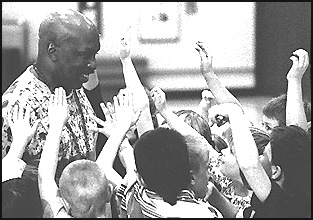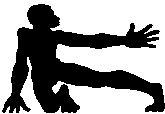Arthur Hall believes teaching and learning never stop. They are the heartbeat of living,
contract, release, learn, teach. He still teaches what he first learned as a young
man aspiring to be a dancer. "At that time I wanted to do Indian dancing," inspired
by the work of Ted Shawn and Ruth St. Dennis, "but I realize now that I was searching
for something I could dedicate myself to.
"I was also impressed by the dances of Joan Kerr working in a contemporary Yiddish idiom,
and she encouraged me to work on bringing traditional African forms to the American stage.
It was also Joan Kerr who arranged our first concert in
1958 at the YWHA," at Broad
and Pine in Philadelphia. "Shawn and Dennis were bringing classical Indian forms to modern
dance, and the Joan Kerr Dancers had these angry Jewish dances that would blow you away.
It was all very exciting to a young man, and the possibilities went on and on.
"I learned dance etiquette and discipline from Marion Cuyjet," of the Judimar School
of Dance in Philadelphia, who also helped mould John Jones and Delores Brown, McCoy Tyner,
Ronald Platts, Elmer Ball, and Judith Jamison. "Ms. Cuyjet was the grande dame,
and she took no tea for the fever. I quess I got my teaching style from her. She was very
strict, a great disciplinarian, but underneath it all you knew she loved you.
"I had danced a little in school, even won some contests, but I didn't know any
technique," Arthur recalls in a 1968 newspaper article. "I joined the [Judimar] school
and later went on to the Katherine Dunham School in New York," where he studied with
Syvilla Fort. Arthur continues to teach Dunham technique to this day.
The real roots of African Festivals in American Schools, however, go back to
Saka Acquaye and the West African Cultural Society. "I studied with him three years, and
during this time I decided to dedicate myself to keeping this lore in America.
After all,
there are 20 million black people here, and I think we must know something of our culture.
Our people are not aware of their culture and heritage. I saw in the dances a
chance to bring
grandeur back into blackness," Arthur is quoted as saying in the
same 1968 article.
Many of the dances in the school repertoire were originally learned from Saka Acquaye
(see
Program notes). The same dances formed the basic repetoire
for the Arthur Hall Afro-American Dance Ensemble, and when the
Ile Ife Center was established in 1968, they were a central part of the children's dance
classes and performances by
The children's company, Omo Ife, and the Junior Company. From its beginning in the 1950s,
the credo for Saka Acquaye's West African Cultural Society was "This is mine. I give it
to you. Add some of yourself, and pass it on." ~ an excellent philosophy for any artist
or teacher at any time. Arthur Hall has carried it with him for over forty years, and
he puts it into practice with each new student, each new class, every rehearsal, every
performance.
Saka's credo implies improvisation within traditional forms, an idea inherent in West
African culture since time immemorial, an idea that has had as much influence on modern art
and contemporary music as it has on modern dance. Inherent in the West African Festival
is an expression of community, a traditional expression alive to the moment.
African Festivals in American Schools has evolved out of Arthur Hall's years of
experience (and discipline and technique) in transposing these traditional concepts to the
concert stage and the classroom. The sense of community comes from meaningful dances,
appropriate for each student's age and ability, adapted to express the reality that the
school is, in fact, a coherent community, albeit one which perhaps never before experienced
itself as an African village. Improvisation insures spontaneity, a sense of newness and
"nowness," and it permits the inclusion of a wide range of influences, like the
Moose Dance in a Maine school or traditional Yoruba carvings that incorporate
motorcycles or jet planes.
Arthur Hall has been creating African Festivals in American Schools for many years
in schools across the country, touching the lives of tens of thousands
(one count by extrapolation puts the figure at about a half million students). He has
taught throughout Africa, including Ghana, Nigeria, Zaire, and Mozambique. He has packed
an amphitheater in Seoul to see Korean African dancers. He has worked in collaboration with
the art historian Perkins Foss to recreate the Urhobo
Water Spirit Festival with 350 children
from two schools, K-3. Last year for the Montana Ballet, there was a festival which
combined Native American Indian, traditional Hawaiian, and student African singers and
dancers. Every festival is different. Each demonstrates the importance of the arts in
education, strengthening the bonds of the school community and the community at large
while enhancing tolerance and appreciation of diverse cultures. In short,
African Festivals in American Schools is affirmative action at the grass roots.

